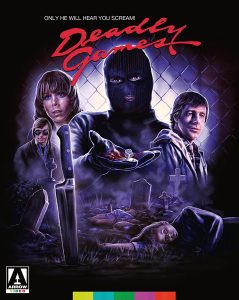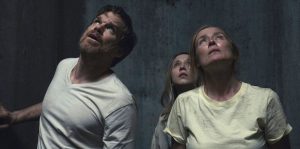As the star of Taika Waititi’s Jojo Rabbit, 12-year-old Roman Griffin Davis was the undisputed darling of the 2019/20 awards season circuit, the unflagging sincerity of his untainted, joyful optimism bringing a little sunshine to all who glimpsed him on a red carpet or talk show or even random interview clip. His breakthrough performance, nominated for a Golden Globe in the Best Actor, Motion Picture Musical or Comedy category, opened doors — and not merely for him. Topping the list appears to be the feature-length screenwriting and directorial debut of his mother Camille Griffin, Silent Night, in which the young actor also co-stars. A uniquely deflating experience full of false beats, wildly misjudged performances, and little discernible social insight, the film is a doomsday dark comedy which may unfortunately linger in the online movie discourse much longer than it deserves, reappearing annually like a canker sore when it comes time to debate, discuss and rank so-called “Christmas movies.”

Taking place in the near future, the film centers on Simon (Matthew Goode) and Nell (Keira Knightley), who host an annual holiday dinner party at their English country estate for a collection of extended family and friends. Among others, this year brings together the coupled Sandra (Annabelle Wallis) and Tony (Rufus Jones), Alex (Kirby Howell-Baptiste) and Bella (Lucy Punch), James (Sope Dirisu) and Sophie (Lily-Rose Depp), and various kids, including Nell and Simon’s distressed oldest child, Art (Roman Griffin Davis). (Rounding out the movie’s “family affair” vibe are Hardy and Gilby Griffin Davis, the twin younger brothers of Roman, and sons of Camille.)
The rub, as slowly revealed to viewers, is that a lethal gas cloud, the product of environmental abuse and destruction, is spreading across the globe, lending the Christmas festivities a decidedly downbeat mood, and contributing to general knives-out bickering plus more pointed intra-couple disagreement about whether to partake in the suicide pills provided to everyone by the British government. Wine is consumed, past sexual performances are judged, old recriminations and grudges are dragged into the light of day, and video chats with far-flung relatives are had, finally dragging viewers to a merciful conclusion.
Griffin clearly fancies herself a chronicler of relationship and class conflict, but her societal surveying contains little shrewdness. The micro-conflicts within the movie come across as a mixture of uninspired and contrived, and are pitched at such a level of spinning-top hysteria that the effect is emotionally draining — and for reasons that have nothing to do with the story that Griffin is actually trying to tell. There’s no proper sense of momentum here, no unfolding trepidation or despair or concern. The young Davis is a bright spot (as are his younger siblings), but there is otherwise not a performance or character here for viewers to really care about.
Silent Night comes to Blu-ray presented in a 2.39:1 widescreen, high-definition 1080p transfer that is color-consistent and free from any grain or edge enhancement. Audio is a strong 5.1 DTS HD master audio track that more than adequately handles the straightforward aural composition and demands of this dialogue-driven movie, presented alongside optional English SDH, Spanish and French subtitles. The release comes in standard packaging with a matted cardboard slipcover, and the disc’s bonus features consist of three separate alternate endings, as well as a collection of deleted and extended scenes totaling just under 14 minutes, the latter of which at least shows Griffin capable of trimming dead narrative branches, even if the movie itself overall still doesn’t work.
Horror films have among the most dedicated fan bases — it’s a genre that endures because it can steadily deliver younger ticket buyers by way of goosing emotional crucibles, plus creative gore. But, as they grow up, many of those viewers stick around and become faithful (rapacious, even) consumers of all types of movies from every conceivable sub-genre of horror, which explains the market for something like the new Blu-ray release of Deadly Games, a mostly forgotten slasher flick from 1982.

Written and directed by Scott Mansfield, the movie (originally titled Who Fell Asleep) centers on a troubled Vietnam War veteran turned projectionist, Billy (Scott Railsback), who reconvenes with a bunch of his old friends after a ski-mask-and-glove-wearing killer starts knocking some of them off. Reporter Keegan (Jo Ann Harris), the new girlfriend of one of the pals, finds her journalistic curiosity piqued, and ends up in the killer’s sights.
Railsback, for an entire generation, retained a creepiness owing to his performance as Charles Manson in 1976’s controversial TV miniseries Helter Skelter, so he makes a perfectly terrifying central presence here. The influence of Italian giallo pictures on Mansfield is obvious, though his faculty with integrating those inspirations and juggling them tonally with other elements and styles is sometimes less successful. What helps separate and elevate Deadly Games a bit is the fact that it indulges mood and pacing a lot more intelligently than a lot of its brethren from the same era. If the mystery at its core doesn’t really totally work, the plotting at least leans into tangled interpersonal relationships and even sexual politics a way that effectively creates some extra layers of tension. (The Big Chill wouldn’t become a smash hit until the following year, but Deadly Games also makes affairs, simmering crushes, and exposed secrets grist for its narrative mill — it just happens to be murders rather than arguments.) To call this a gem is gross overstatement but, all in all, horror fans won’t be entirely disappointed if they end up taking a flyer on this unearthed curio.
Arrow Video has made mining the horror genre — and most especially all the types of titles which you might remember a VHS cover box of, but little else — a core part of their mission, and they do so fantastically. The release of Deadly Games is no different. Its Blu-ay release, in a clear amaray case with a title-embossed slipcover with reversible cover art, comes loaded with bonus features, and is anchored by a brand new 2K restoration from cinematographer R. Michael Stringer’s original camera negative, along with an uncompressed mono audio track. Podcast collective “The Hysteria Continues” contributes an engaging feature-length audio commentary track which nicely blends very well-schooled, genre-appropriate props and evaluations with some acknowledgement of areas in which the movie falls a bit short. Robust images galleries feature 90-plus photos, including a selection of never-before-seen production photos, and brand new interviews with actor Jere Rae-Mansfield and special effects and stunt coordinator John Eggett, each over 20 minutes, also provide some nice perspective. For those interested in tracking changes to the final version, there’s a copy of the original screenplay available via BD-ROM drive; rounding it all out is a very nice 24-page full-color booklet featuring restoration details, an essay from Amanda Reyes entitled “The Games People Play: Exploring the Midwestern Gothic in Deadly Games,” and cast and crew information.
There’s an abundance of weird, discordant energy coursing through the minds and bodies of adolescents, perhaps especially males, even before the hormonal kick of puberty takes over. One needn’t be a “bad kid,” or either from or in difficult circumstances, to necessarily act out in misplaced or odd ways; before moral reasoning and judgment centers harden, the reality is that there are certain times when the inscrutable actions of youngsters can simply be best explained by way of a neon sign that could be permanently affixed above their head to describe the present state of their brain: “under construction.”
Few films attempt to assay this curious state (to say nothing of trying to capture it) with quite the studied ambitiousness as John and the Hole, an atmospheric coming-of-age drama that represents the auspicious feature directorial debut of Spanish-born filmmaker Pascual Sisto. Adapted by Argentine screenwriter Nicolás Giacobone (a frequent collaborator of Alejandro Gonzalez Iñárritu) from his own short story El Pozo, Sisto’s movie mines its deliciously strange yet simple premise for profound unease, resulting in a divisive work that a good many viewers, perhaps not wanting to sit with some of its uncomfortable latent truths, will reflexively dismiss as simply “weird.”

The story centers on John (Charlie Shotwell), a quiet kid who lives in a tucked-away house in a neighborhood which abuts the woods. In that forest exists a deep pit of poured concrete — the remnants of a once-planned bomb shelter, never finished. With seemingly no provocation, one night John drugs his parents (Michael C. Hall and Jennifer Ehle) and older sister Laurie (Taissa Farmiga), and places them in this hole. Occasionally taking them food, water, and blankets, John then simply goes about his regular activities — playing videogames, hanging out with a friend, going to tennis practice — while his family, stuck with no way to get out, spends time trying to dissect the root cause of his action, with his mother recalling John’s seeming dissatisfaction with her answer to his plaintive query, “When do you stop feeling like a kid?”
The movie is marked by a few moments of creepiness, as when the prepubescent John practices effectively mimicking the voices of both of his parents, in preparation of phone calls which cover his tracks. There is a moment or two, as well, of unusually constructed tension, as when John and his friend engage in a dangerous adolescent game. There’s also the requisite secondary adult figure, a friend of John’s mother, who starts to wonder what is really going on, and test some of the pressure points of John’s stories. But for the most part it’s surprising how little John and the Hole is really plot-driven, or concerned with escalating anxiousness or anticipation; it’s is a character study wrapped in the false guise of a ticking-clock thriller.
Abetted by an evocative, high-ceilinged modular synth score from composer Caterina Barbieri that taps into rich feelings of youthful confusion, Sisto and editor Sara Shaw create a film of naturally undulating rhythms — one in which small scenes of quietude seem to both contain and build to larger emotional truths. This isn’t mere “mood” for mood’s sake, a point underscored further by a parallel narrative device which lends allegorical weight to the main story. John and the Hole is instead an examination of identity, and rumination on emerging personality. In exploring the confusing dividing line between adulthood and adolescence, Sisto and his well-focused, on-the-same-page collaborators craft an engaging, off-kilter fairytale which provokes rather than answers questions.
John and the Hole comes to Blu-ray in a standard case, with a complementary cardboard slipcover. It’s presented in a 1080p high-definition 1.33:1 aspect ratio, with a DTS-HD master audio 5.1 soundtrack and optional English subtitles for the deaf and hard-of-hearing. Apart from trailers, there are no supplemental bonus features.
An international programmer and pipeline-filler through and through, Invincible serves up streamlined action beats which work best as audio-video background noise while also completing some other tasks. Director Daniel Zirilli’s film deposits injured soldier Brock Cortez (Marko Zaror) at a secret military site, where he’s treated with corrupted nanotechnology which turns him into an uncontrollable killing machine. Cam Devore (Johnny Strong) is sent in to neutralize Brock but gets injured, requiring him to then submit to the same injected elements that transformed Brock.
Modified-military-man killer-thrillers are their own rich action sub-genre, but frequently lean heavily into the science-fiction element (if they have the budget) or brush past it and focus on the choreographed fisticuffs. Invincible is very much in the mold of the latter. There’s a bit of extra care or attention around the edges (Michael Paré and Sally Kirkland pop up in supporting roles), and things are set up and in motion with a billionaire investor character and what not, but Zirilli is invested primarily in his movie’s hand-to-hand action combat. This is fine enough for fans of whirling and clubbing, but there aren’t really any “plus-factor” elements here — in terms of production design, staging, or narrative inventiveness — that elevate this into anything memorable.
Presented in a standard case, Invincible comes to DVD in a 2.39:1 widescreen presentation, with a 5.1 Dolby audio track, plus optional English SDH, Spanish, and French subtitles. There is, perhaps unsurprisingly, no accompanying feature-length audio commentary track or erudite essay from a noted film historian.
Written by: Brent Simon
